
To break free from the cycle of constant “firefighting” and focus on what really matters, task prioritisation must follow clear rules. Keep reading to learn what it means to set priorities correctly, which popular business methods can help, and how to decide which tasks deserve immediate attention and which can wait until the next sprint.
What Is Prioritisation?
Prioritisation is the process of ordering tasks based on their importance and urgency. The goal is to ensure that limited resources and attention are directed where they create the most value.
When employees understand why a task truly matters, unnecessary overtime disappears. Managers can allocate resources more effectively, delegate responsibilities, and share accountability across the team, while daily actions remain aligned with the overall strategy. As a result, each participant has time not only for their duties but also for short breaks — whether that means betting on upcoming matches via the tonybet sportsbook, chatting with colleagues, or taking a brisk walk.
How the RICE Model Works
RICE is a structured methodology that helps determine which tasks deserve time and investment first. Its core idea is to turn gut feelings into numbers using four factors: Reach, Impact, Confidence, and Effort.
- Reach answers the question: “How many users will experience the result within the chosen timeframe — a week, a month, or a quarter?” This could mean thousands of active customers, a set number of orders, or completed sessions. The key is to define a specific unit.
- Impact measures how strongly a task influences a process, project, or product. The score is set on a scale:
- 3 points — maximum value, strong influence
- 0.5 points — minimum value, barely noticeable effect
- Confidence reflects how certain you are about the Reach, Impact, and Effort estimates. This can be expressed in percentages or on a 10-point scale. A confidence score of 50% or below signals a lack of solid analytical data.
- Effort represents the workload required, measured in person-months spent completing the task.
The formula looks like this:
(Reach × Impact) × Confidence ÷ Effort
How the ICE Model Works
The ICE model also helps prioritise tasks and shares some elements with RICE but has its own focus. ICE stands for Impact, Confidence, and Ease.
The team lists all potential tasks, and each one is scored on a scale of 1 to 10 for three criteria:
- Impact — the potential effect on the process or project
- Confidence — the strength of evidence supporting the idea
- Ease — how simple the task is to implement
The final score is calculated as:
Impact × Confidence × Ease
How the WSJF Model Works
WSJF (Weighted Shortest Job First) is a prioritisation method rooted in Lean principles and adopted as the official approach within the SAFe framework. Its guiding principle is simple: “Do the most valuable and least complex tasks first.”
The formula is:
Cost of Delay ÷ Job Size
Cost of Delay is made up of several factors:
- Business Value — the benefit of completing the task
- Time Criticality — urgency of implementation
- Risk Reduction — decreased risks after completion
- Opportunity Enablement — opportunities created by success
Job Size refers to the resources required, measured in person-days or story points.
Thus, the full formula is:
WSJF = (Business Value + Risk Reduction/Opportunity Enablement + Time Criticality) ÷ Job Size
Which Model to Choose
These three approaches differ in objectivity, focus, and ease of use. Each has its strengths and weaknesses.
RICE is best when:
- You have access to large volumes of data and the ability to analyse it
- Impartiality is required — the company already has insights about customers, workflows, and a mature product team
ICE works well when:
- You need a quick evaluation of task importance
- There’s little concrete information about the market, users, or product — making it ideal for startups
WSJF is suitable when:
- The company has reliable performance data
- There is enough time for calculations
- Maximum objectivity is essential
Prioritisation is all about choosing what not to do right now. Whether you use RICE, ICE, or WSJF, the ultimate goal is the same: aligning daily work with strategic outcomes and ensuring that every effort counts.

Leave a Reply